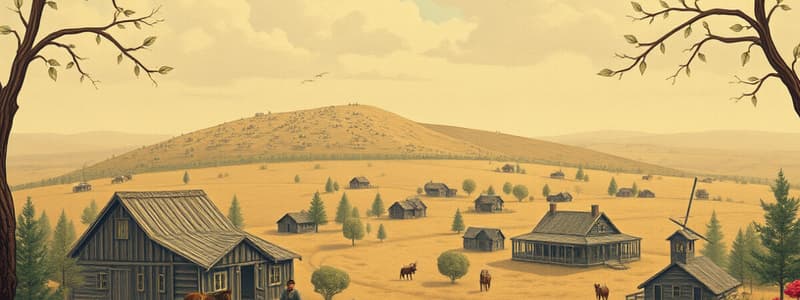Podcast
Questions and Answers
What did the Homestead Act of 1862 offer to settlers?
What did the Homestead Act of 1862 offer to settlers?
- Land only for veterans
- 320 acres of land for a $10 fee
- 160 acres of land at no cost (correct)
- 40 acres of land
What was the purpose of the Morrill Land-Grant Act?
What was the purpose of the Morrill Land-Grant Act?
To transfer federal land to states for agricultural colleges
Who were the Exodusters?
Who were the Exodusters?
African Americans moving to the West to escape violence
The transcontinental railway was completed in 1876.
The transcontinental railway was completed in 1876.
What was a significant consequence of the transcontinental railway on buffalo populations?
What was a significant consequence of the transcontinental railway on buffalo populations?
What were the two most well-known strikes of gold and silver?
What were the two most well-known strikes of gold and silver?
Match the following terms with their definitions:
Match the following terms with their definitions:
What led to the end of the cowboy era?
What led to the end of the cowboy era?
What challenges did homesteaders face on the Great Plains?
What challenges did homesteaders face on the Great Plains?
What was the Reservation Policy?
What was the Reservation Policy?
What happened at the Sand Creek Massacre?
What happened at the Sand Creek Massacre?
Flashcards are hidden until you start studying
Study Notes
Homestead Act of 1862
- Encouraged Westward settlement by offering 160 acres for a $10 filing fee.
- Required settlers to live on the land for five years.
- Land was often taken by speculators, undermining the act's intent.
Morrill Land-Grant Act
- Transferred over 140 million acres of federal land to states for agricultural college development.
- Land often ended up with speculators who profited from sales.
Exodusters
- African Americans fleeing violence in the South, approximately 50,000 migrated to Kansas.
- Encountered hostility from groups like the Ku Klux Klan in their new settlements.
Transcontinental Railway
- Completed in 1869, it connected the Atlantic and Pacific Oceans.
- Facilitated movement, trade, and migration across the continent.
Buffalo
- The construction of railroads contributed to a dramatic decline in buffalo populations, as many were killed for sport.
- The buffalo's decline severely impacted Native American tribes reliant on them for sustenance.
Comstock Lode and Pikes Peak
- Notable gold and silver strikes that attracted miners and prospectors to the West.
- Comstock Lode located in Nevada; Pikes Peak in Colorado.
Mining Frontier
- Attracted tens of thousands of prospectors, with many unsuccessfully seeking wealth.
- Many prospectors ended up working for mining companies instead of striking it rich.
Effects of the Mining Frontier
- Some mining towns became ghost towns, while others like San Francisco and Denver thrived.
- Strikes led to statehood for areas such as Nevada.
- Increased precious metal supply caused political currency debates.
The Cattle Frontier
- Cattle ranching thrived post-buffalo decimation due to rising beef demand and open grasslands.
- Railways facilitated the transport of cattle to markets.
Cowboys
- Cowboys managed cattle herds across the plains, leading them to rail towns for shipping.
- The cowboy demographic included primarily white cowboys, with 25% African-American and 12% Mexican.
- The cowboy era lasted from 1866 to 1886.
End of the Cowboy Era
- Ended due to droughts, severe blizzards in 1887, and the invention of barbed wire restricting grazing lands.
Farming Frontier on the Great Plains
- Homesteaders faced harsh conditions: extreme weather, isolation, water scarcity, and pest infestations.
- Many farms failed, as the agricultural sector became increasingly commercialized.
Reservation
- In 1834, the Great Plains were designated as a reservation for Native Americans by the US government.
Reservation Policy
- Federal government assigned specific lands to Native American nations, causing conflicts due to nomadic lifestyles and unrecognized treaties.
- Encroachment on traditional hunting lands led to clashes between settlers and Native Americans.
The Sand Creek Massacre
- Occurred in Colorado, where Colonel John M. Chivington's militia killed over 400 Cheyenne men, women, and children.
Defeat of the Sioux
- Notable conflicts arose between white settlers and the Sioux nation, marking significant tensions during this period.
Studying That Suits You
Use AI to generate personalized quizzes and flashcards to suit your learning preferences.




